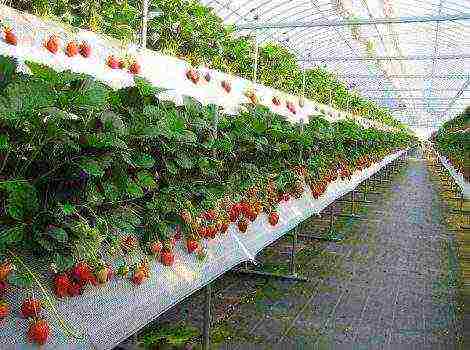Content [show]
Every year there are more and more people who want to taste self-grown fruits in their home garden. In addition to the usual tomatoes, cucumbers and various greens, you can grow strawberries all year round on the windowsill of the house. In winter, it is especially pleasant to enjoy homemade berries.
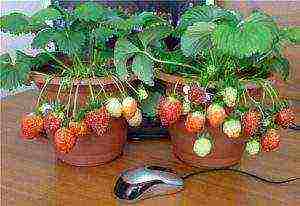
Features of growing on a windowsill
Having decided to grow strawberries on a windowsill, first of all, you need to choose the right planting material. The fact is that indoors it is better to grow varieties that are unpretentious to environmental conditions.
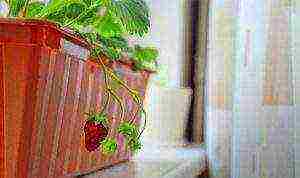
In addition, a special microclimate must be created in the room where the containers will be located. So that the strawberries do not hurt and grow quickly, you need to set a comfortable temperature in the room. It is equally important to control the level of lighting and humidity throughout the growing season.
Which varieties are suitable for growing on a windowsill
It is necessary to choose planting material very carefully, contrary to common misconception,greenhouse strawberry varieties are not suitable for growing in an apartment... When choosing seedlings of indoor strawberries, you need to pay attention not to the appearance of the plant, but to its characteristics.
Strawberry seedlings, for growing at home on a windowsill, should be renovation, unpretentious to the length of daylight hours and temperature. The ampelous bushes that hang from hanging containers look especially beautiful in the apartment.
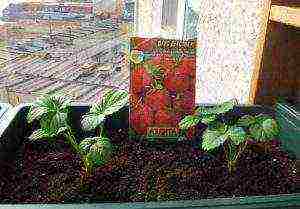
For year-round cultivation of strawberries on a windowsill at home, it is best to choose varieties such as Supreme, Geneva, Queen Elizabeth. The cultivation of the mustache-free variety Home Delicacy, Tristan, Selva, shows good results.
Video: how to grow strawberries (garden strawberries) from seeds on a windowsill
How to plant and grow on a windowsill - features, conditions and step-by-step instructions
To successfully plant and grow strawberries at home on a windowsill, certain rules and conditions must be followed. Let's talk about them in more detail below.
A place
The best place to grow remontant strawberries is a south- or east-facing windowsill. It is possible to grow a culture on the eastern and northern windowsill only under the condition of constant supplementary lighting.
Daylight hours
For rapid growth and ripening of garden strawberries, the duration of daylight hours should be 12-14 hours. If in the summer there is enough sunlight for the bushes, then in the fall and winter, when the light part of the day is very short, strawberries need illuminate with fluorescent lamps. Lighting devices are turned on 2 times a day: from 8 to 11 hours and from 16 to 19 hours.

Temperature
It is important to maintain the temperature when growing strawberries at home. + 18- + 20 C. If the temperature is a few degrees lower, the plants begin to ache. To prevent such unpleasant consequences, it will be necessary to turn on the heaters in the fall and spring.
Humidity
Strawberries will feel good if the humidity does not exceed 70-75%. In the midst of the heating season, in winter, when the air in the apartment is very dry, bushes sprayed from a spray bottle with settled water at room temperature. However, even in this case, it is worth adhering to the measure: due to the high humidity in strawberries, resistance to fungal diseases decreases.
What container to plant
Suitable for planting bush seedlings small pots. Ampel species feel great in hanging pots. Seedlings, which have formed 5-6 leaves, are planted in a 3 liter pot. The seeds are planted in small cups, and as soon as they release the first pair of leaves, they are transplanted into spacious permanent containers.

You can also plant plants in long boxes with a volume of 10-15 liters... When landing in such containers the distance between the bushes must be at least 20 cm... Regardless of the size, there should be holes in the bottom of the planting container for excess water to drain.
What kind of soil (substrate)
You can buy potting potting soil at a specialist store or make your own. Suitable for indoor strawberries any substrate intended for growing vegetables and flowers.
To prepare the soil with your own hands, coniferous earth, sand and humus are mixed in equal parts in a container. Also, strawberries grow well in a substrate of peat and vermicompost.

The main condition that should be met when preparing the substrate isthe potting mix should be airy and slightly damp. At the end of the preparation of the substrate, phosphorus fertilizers are introduced into it.
Important! It is highly undesirable to use soil from the garden for planting strawberry seedlings at home: it can be infected with nematodes and other dangerous larvae. If there is no other option, you need to check it before using the garden soil, and then spill it with a low-concentrated solution of potassium permanganate. You can start planting bushes a week after disinfection.
Preparation of planting material
Experienced gardeners recommend growing strawberries at home on a windowsill with seedlings, since growing seedlings from seeds on their own is quite a long and troublesome business. Planting material can be purchased in nurseries or taken from your site, if there are remontant varieties.
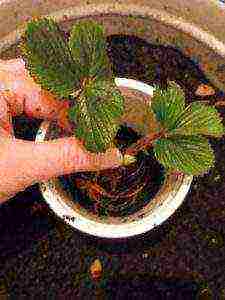
The preparation of strawberry seedlings for planting at home is carried out as follows:
- From the available sockets, only the the largest and healthiest.
- Planting material separated from the mother plant and planted in a pot.
- To give the strawberries a dormant period, the container is placed in a cool place for 14 days - basement or cellar.
Direct landing
Since strawberries do not like stagnant water and compacted soil, pebbles, expanded clay, small pieces of slate or brick are covered at the bottom of the pot before planting.

Saplings strawberries are planted at home like this:
- A drainage layer and a little substrate are poured into the pot.
- The rhizome is dipped in a weak solution of potassium permanganate for a few minutes.
- Plants are placed in a pot and the roots are spread. The root must be full-grown in the pot. The rhizome must be shortened if the tip has to be strongly bent during planting.
- In order for the cut bushes to recover faster, they are immersed in a weak solution of heteroauxin for 3-4 hours. To prepare the mixture, a crushed tablet of the drug is dissolved in 5 liters of water.
- They fill up the missing soil to the point of growth and crush it a little.
- To improve the survival rate, the bushes are moderately watered with a solution of heteroauxin
You can use seeds to grow strawberries at home on a windowsill. Despite the fact that the harvest will have to wait longer than when planting seedlings, this does not scare off gardeners who do not see their life without their favorite business.

In order for the seeds to sprout together, they need to be hardened. The planting material is laid out on a damp cloth, then it is folded in half and placed in a bag. The bookmark is then sent to the top of the refrigerator for 30 days.
The sequence of planting strawberries at home on the windowsill seeds:
- A shallow box is covered with prepared soil for most of it and slightly moistened.
- Keeping a distance, the seeds are laid out in rows.
- The planting material is sprinkled with a thin layer of soil.
- The seedling container is covered with polyethylene or glass and placed in a warm place.
- As soon as the seedlings germinate, the shelters are gradually removed, and the container is placed on a light windowsill.
- Plants with a pair of real leaves are transplanted into a spacious pot.
The optimal time for planting strawberry seedlings in an apartment is early spring or the period from August 15 to September 20.
Video: how to care for and grow strawberries at home in a pot
How to care after planting and before harvest
Watering. For watering strawberries, like other indoor plants, use only settled water at room temperature. In order not to wait for the chlorine to settle to the bottom of the container, water can be passed through a filter.
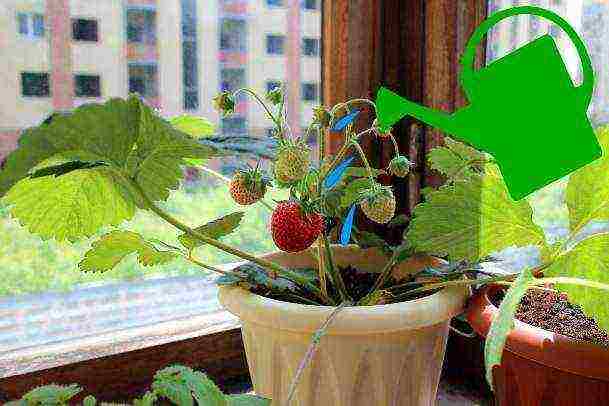
Adhering to the technology of cultivating strawberries at home on the windowsill, the soil in the containers is moistened 2 times a week. It is best to moisturize the soil in the afternoon. After watering, the soil in the planting container is loosened.
Important! Despite the fact that the growth of strawberries after the next moistening is activated, it is impossible to get carried away with watering. Overflowing plants is fraught with the appearance of rot on the roots and fungal diseases. Stagnant water is especially dangerous for bushes.
Top dressing. It is recommended to feed indoor strawberries once every 14 days. As fertilizer, you can use conventional houseplant feed or special strawberry nutrient mixtures. Top dressing is applied in accordance with the manufacturer's recommendations. They begin to be brought in after the 5th leaf appears on the bush.

If you do not want to use industrial mixtures, you can prepare food for indoor strawberries yourself according to this recipe:
- A 3-liter jar is covered by a third of crushed eggshells.
- Then 1 glass of ash is poured and the jar is filled to the top with slightly warmed water.
- At the end of 5 days of infusion, the solution is filtered.
- Before making the top dressing is diluted with water 1: 3.
You can also fertilize strawberries on the windowsill with weak solutions. mullein, chicken droppings.
Note! It is impossible to overfeed strawberries with fertilizers: a large amount of nutrients stimulates the active growth of leaves and has a bad effect on the setting and formation of fruits.
During fruiting, the bushes need a lot of iron. According to the reviews of experienced gardeners, in order to enrich the soil with a chemical element, a rusty nail must be driven into the pot a few centimeters. Admirers of the use of commercial mixtures spray the plantings with solutions containing iron compounds.
After harvesting, the bushes are rarely fed or not fed at all.
Pruning. Many will be surprised, but strawberries need to be pruned in order to increase yields. How to prune strawberries grown at home on a windowsill?
- On seedlings grown from seeds, the first few flowers are plucked. It is not necessary to cut off the flower stalks on strawberries, divorced from seedlings.
- If further expansion of indoor plantings is not planned, and it is not necessary to replace adult bushes, the antennae must be cut off. Also, cropping is recommended when there is a lack of lighting. As a result of shearing, the plants will not be wasted on the formation of unnecessary outlets, but will direct all the nutrients to the fruits.
Pollination. In order for berries to set after flowering, the strawberries need to be pollinated. There are several ways to artificially pollinate at home:
- By the blossoming flowers one by one holding a paintbrush throughout the entire flowering period.
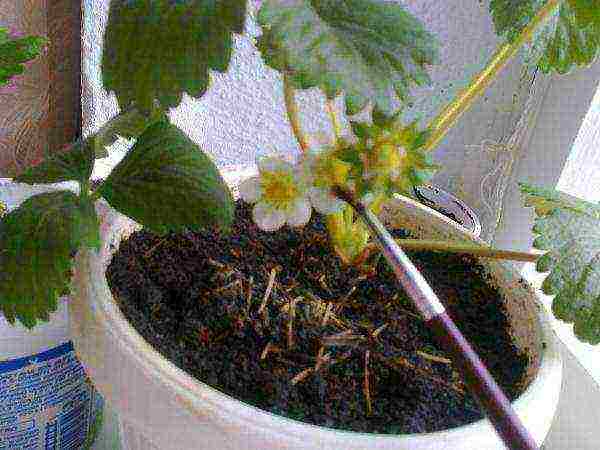
- A fan is directed at the plants. Under the flow of air, pollen from one flower is transferred to another and the strawberries are pollinated.
Video: growing strawberries in winter
Diseases and pests
During fruiting, strawberries are affected gray rot and spider mites. To get rid of the worst enemies of sweet berries, plantings are sprayed garlic tincture. To prepare the solution, 2 vegetable slices are crushed and 100 ml of water is poured. The mixture, infused for 2 hours, is filtered, poured into a spray bottle and the plants are treated.
Terms of germination and harvesting
Strawberry seeds planted in an apartment sprout for a rather long time: the first seedlings make their way to the surface 20-30 days after sowing.
Repaired strawberries, grown at home on a windowsill, bloom in 30-35 days, and ripe berries begin to be picked 60-65 days after planting.
Video: strawberries on the windowsill in winter
The year-round cultivation of remontant strawberries on the windowsill is an exciting activity that does not require so much time and effort. All troubles and difficulties will pay off a hundredfold with ecologically clean and tasty fruits.

Just the word "strawberry" in the mouth feels its amazing sweetness, and pleasant images float before your eyes: ripe strawberries on a bush, warmed by the sun; strawberries with cream; delicate dessert decorated with strawberries ...
The main secrets and subtleties of year-round strawberry cultivation
In summer, this delicious berry is quite often present on our table, but imagine how surprised guests and households will be if you delight them with fresh strawberries in the “off-season”! And not that imported berry that is on the shelves of supermarkets, raising doubts about its usefulness, but the most real homemade strawberries, juicy and aromatic.
Nowadays, anyone who has such a desire can do strawberry cultivation all year round. To do this, it is not at all necessary to have a heated greenhouse; you can also grow a berry in an ordinary flower pot on the kitchen window. All that is required of you: stock up on seedlings, earth, containers for strawberry seedlings and, of course, patience, because strawberries are a rather capricious plant.

Anyone who has such a desire can do strawberry cultivation all year round.
How can you get strawberry bushes to bear fruit in autumn, winter and spring? The secret is simple: in a dormant state, strawberry seedlings dug from your site in the fall can be stored for up to nine months, for this you just need to keep it in the refrigerator or in a cool basement. In their natural environment, strawberries "wake up" after the snow melts, and when storing at home, you can "wake up" the seedlings at the moment you want. Thus, taking out alternately the bushes of seedlings from the basement or refrigerator and planting them in the ground, you can get the desired result - strawberries will bear fruit all year round without interruption.
Video about growing strawberries all year round
Another important point that you will definitely need to take into account is that strawberry seedlings need a long day of light (up to 14 hours a day). In the autumn-winter period, the days are very short, so you will have to use artificial lighting. Any of the technologies for growing strawberries all year round is based on the fact that the plants are provided with additional illumination using fluorescent lamps.
Pollination of flowers will also be artificial, regardless of which strawberry varieties you have chosen for year-round cultivation. If you have planted several strawberry bushes at home or in a greenhouse, you can pollinate them with a simple soft brush, touching each flower with it daily. In large greenhouses, a bee hive can be placed to ensure natural pollination.
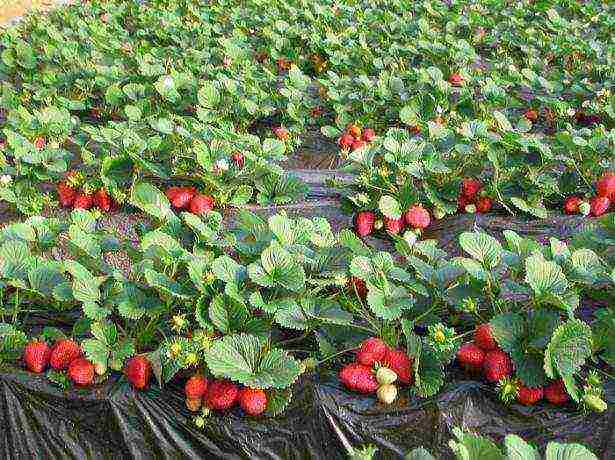
If you have planted several strawberry bushes at home or in a greenhouse, you can pollinate them with a simple soft brush.
Strawberries bear fruit best of all year round, varieties of which are distinguished by high yields and the ability to set berries several times after the first fruiting. These are varieties such as:
- Marmolada,
- Maria,
- Selva,
- Darselect,
- Tristar,
- Elsanta,
- Yellow miracle
- Polka,
- Sonata,
- Tribute,
- Mount Everest,
- Darkness,
- Queen Elizabeth.
What is the best way to grow strawberries in winter?
There are many ways to grow strawberries all year round: some are based on the principles of hydroponics (growing without soil), others involve the use of plastic bags. You can choose any method that you consider the most effective and acceptable.

The growing popularity is gaining year-round cultivation of strawberry seedlings in bags.
The growing popularity is gaining year-round cultivation of strawberry seedlings in bags on the balcony and on the loggia. Substrate is poured into ordinary long bags of dense polyethylene, slots are made on the surface for strawberry bushes, and seedlings are planted. Having chosen this option, do not forget to constantly ventilate the room in which the bags with growing strawberries are located, otherwise the roots of the plants will rot.
The strawberries that we can see in the supermarket in winter are grown using Dutch technology. In fact, this technology is very similar to the one described above, only it is used mainly in greenhouses. If you live in a city apartment and do not have a greenhouse, but really want to get strawberries all year round, a practical guide to the Dutch method will help you achieve a high yield at home.
Video about growing strawberries all year round in bags indoors
You can plant strawberries one bush at a time in flower pots, using rosettes harvested in the fall or growing seedlings from strawberry seeds yourself. If you follow the basic rules for caring for strawberries at home, delicious berries will blush on your windowsill throughout the year.
Another option is to use a hydroponic system. In this case, strawberry seedlings are planted in an organic substrate (for example, coconut fiber) or in an aquatic environment, and a nutrient solution is supplied to the plant roots. As a result, strawberries bear fruit all year round - the video will allow you to make sure that a sufficiently large berry ripens in a hydroponic installation without using a substrate on strawberry bushes.
Rate the article:
(1 vote, average: 5 out of 5)
To grow strawberries at home on the window, it is enough to allocate space on the windowsill, prepare a flower box, and know the basic rules of care. We will tell you about the choice of variety, dressing and technology for growing strawberries at home all year round.
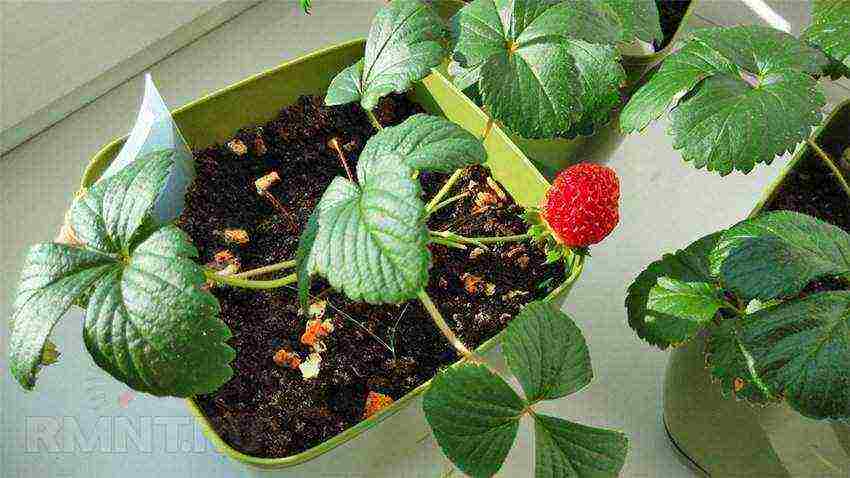
To grow your favorite seasonal berries, it is not necessary to equip a greenhouse, it is enough to select a windowsill on the sunny side and take care of the plants, providing conditions for full growth and fruiting. At the start, you need to decide on the variety of berries, on which the subsequent result depends.
Variety selection
For home cultivation of strawberries, you need to choose remontant varieties. They bear fruit more than once a year, like ordinary ones, but two or more, moreover, abundantly. However, both nutrition and care must be relevant, that is, appropriate.
Repair strawberries are divided into several categories, depending on the length of daylight hours. It is called that, only in an abbreviation: DSD - long daylight hours, and NSD - neutral daylight hours, which is more typical for most regions.
Varieties where flower buds are born with long daylight hours bear fruit twice a year: in early summer and early autumn. Also, DSD varieties are characterized by predominant fruiting for the second harvest. Its share is 60–90% of the total mass of berries.
The second category of remontant strawberries is able to bear fruit continuously all year round. This species is not whimsical to care for, it is resistant to variable humidity, lighting and unstable temperature conditions.These features are key when choosing a variety for home cultivation and regular fruiting.
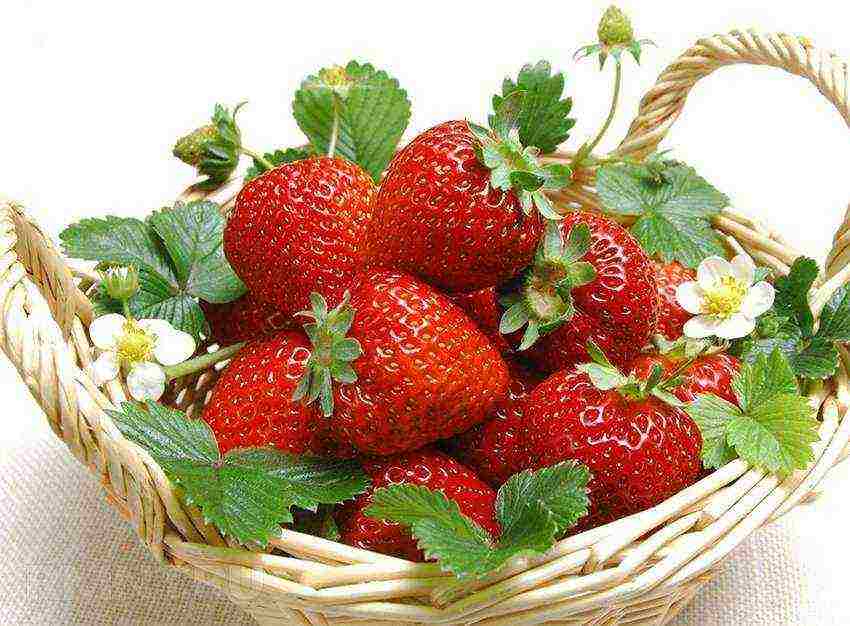
Light-loving remontant strawberry varieties include: "Inexhaustible", "Autumn fun", "Crimean", "Garland". The unpretentious neutral species include: "Queen Elizabeth" I and II, "Brighton", "Roman F1", etc. It should be noted that the variety "Queen Elizabeth" surpasses other varieties in terms of the number and size of fruits, the frequency of fruiting.
Seeds or seedlings
If you decide to speed up or facilitate the process and buy ready-made seedlings, pay attention to the development of the plant. A good sign of a healthy bush is the presence of 3-5 developed leaves and an embryo (buds for ripening future berries). It is better to buy seedlings in a specialized store, then you can count on compliance with the declared variety and the proper quality of the planting material. Ready-made seedlings can be planted in separate pots or long flower boxes at a distance of 15 cm.
Seed planting
Seed preparation
The seeds should be worked a little. To sow seeds and get healthy seedlings at home, you need:
- Soaking the seeds will speed up the germination process. To do this, take a transparent plastic container with a lid and punch holes in it with a sewing needle. This is necessary for air circulation.
- Cover the bottom of the container with gauze or cotton pads. Dampen material and spread seeds. Cover them with damp cotton pads on top.
- Close the container with a lid and place in a warm place for 2-3 days. If you are soaking multiple varieties, be sure to mark the containers accordingly.
- Now proceed with the stratification (hardening) of the seeds. This is necessary to simulate winter weather conditions, in order to accelerate the awakening of seeds and get fast germination. Place the container with cotton pads in the refrigerator. Remember to control the humidity level. Open the container lid every 1-2 days and moisten the cotton pads.
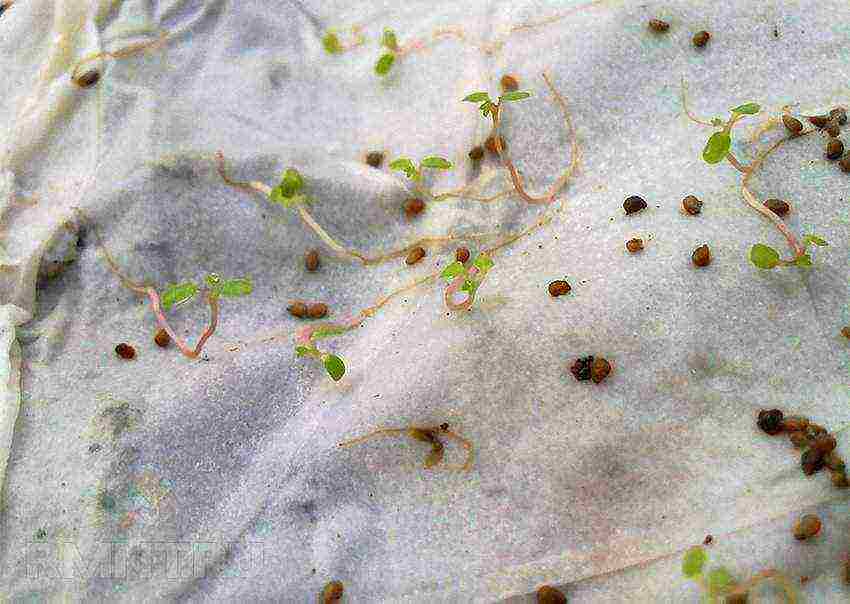
After two weeks, the seeds are ready for sowing in the ground.
Soil preparation
To grow strawberries at home, you can use garden soil or purchase an all-purpose mix at the store. The earth should be crumbly. The best option: mix in equal proportions forest soil, garden soil, and sand. Soil preparation should be started in conjunction with seed stratification.
Disinfect the soil by heating it in the oven for 20-30 minutes. However, beneficial bacteria are destroyed along with the parasites. Allow the soil to cool down for 2-3 weeks to restore nutrient balance. During this time, the seeds will go through the stratification stage and will be ready for sowing.
Sowing seeds
For sowing seeds, you can use improvised containers: plastic boxes, flower pots, cardboard boxes. The height of the sides should be at least 10 cm. Fill the container with earth and start sowing seeds:
- Use a pencil to make shallow grooves of 0.7–1 cm with a distance of 3–4 cm.
- Since the germination rate of seeds is about 40%, it is necessary to sow the seeds often.
- Gently grind the grooves with soil, no more than 0.5 cm.
- Cover the container with plastic wrap and place in a warm place for 4-5 days.
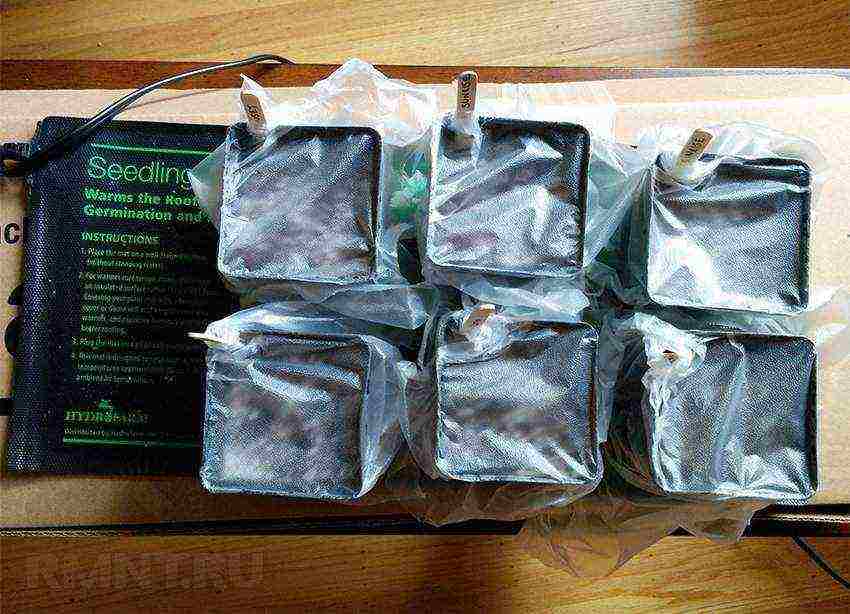
After the first leaves appear, remove the film and transfer the container with seedlings to a well-lit place. Better if it is a windowsill on the south side.

When the seeds have released several pairs of leaves, the seedlings can be dived into separate permanent containers.
Take a spacious wooden or plastic box, pour a thin layer (1–2 cm) of expanded clay or fine gravel on the bottom for drainage. Pour the second layer on fertile soil. The depth of the earthen "cushion" should be 10-15 cm.
Make holes 8–12 cm apart and plant the seedlings. Moisten the soil regularly.
Knowing how to grow seedlings from seeds, you can choose any variety of strawberries and gain invaluable experience and a bountiful harvest year-round. If the strawberry grows, transplant the newly formed bushes into separate containers.
A few tips:
- Mature plants do not tolerate transplanting well. When planting seedlings, choose a spacious container in which the plant will live for a long time.
- The capacity can be any, if its volume is not less than three liters per one bush. If you take, for example, long balcony boxes with a volume of about 15 liters, then you can plant 5-7 strawberry bushes, at a distance of at least 15 cm. This need is associated with the active growth and development of the plant.
- The bottom of the tank must be laid out with a layer of drainage (you can take expanded clay, pebbles or broken brick).
Care and feeding
Strawberries are not whimsical to care for. Growth stimulants should not be used - with a sufficient amount of ultraviolet radiation and optimal humidity, the plants will regularly bear fruit.
Microclimate
It is better to place pots with plants on windowsills facing the east or southeast side. The quality of the fruit directly depends on the amount of sunlight. To circulate fresh air, it is sufficient to leave the window sash in the ventilation position.
If in your region the climate does not often please with sunny weather, then it makes sense to buy the simplest ultraviolet lamp that will promote photosynthesis all year round. Remember to keep the soil moist.
To prevent plants from drying out during your absence, resort to the greenhouse effect method. To do this, moisten the soil well, and cover the container with the plant with a film or plastic bag. Do not forget about the "breath" of plants: make holes for air circulation.
Top dressing
Strawberries must be nourished with nutrients. To do this, you can use mineral and organic complexes: nitrophoska, potassium nitrate, potassium sulfate, wood ash, etc. The first feeding should be carried out during the growing season, with the formation of a couple of real leaves. Choose your favorite top dressing recipes, and alternate their use 4 times a year, excluding the fruiting period:
- 1 tsp nitroammophos for 5 liters of water;
- 1/2 tsp boric acid, 15 drops of iodine, 1/2 cup of wood ash per 5 liters of water;
- Soak a liter jar of crusts and slices of rye bread in two liters of warm water, keep for 7 days in a warm place. Add three parts of warm water to one part of the sourdough, and add top dressing to the plant;
- Dilute 1 part of sour milk or whey with 3 parts of water;
- mix a tablespoon of nitrophoska with a teaspoon of potassium sulfate in 5 liters of water;
- 1 tbsp. l. Dissolve potassium nitrate in 5 liters of water;
- 50 grams of wood ash per 5 liters of water.
Top dressing should be carried out during the growing season and flowering, as well as after picking berries. At this time, new roots are formed, buds are formed for the next fruiting season. It is important at this time to pay maximum attention to the strawberries.
As a rule, strawberries at home are not susceptible to disease. The only feature is the lifespan of plants. Since strawberries of the NSD varieties bear fruit more abundantly and more often, which means it ages faster, its lifespan is 1 year. As for the varieties of DSD, the fruiting of which is several times poorer than the NSD, then their lifespan will increase proportionally and is 2-3 years.
Table of contents:
- Why strawberries are attractive
- Strawberry cultivation methods
- Growing strawberries outdoors
- Growing strawberries in greenhouses
- Growing strawberries in plastic bags
- Growing strawberries using hydroponics
- Strawberry varieties suitable for year-round cultivation
There is hardly a person who would be indifferent to strawberries, or, as it is also called, strawberries.Despite the fact that the blanks from it are also very tasty, not a single gardener will refuse to delight themselves with fresh berries all year round.

Growing strawberries in the open field does not require any special preparation of the land.
In addition, growing strawberries, regardless of the season, is also a good way of earning money.
Why strawberries are attractive
This berry is a storehouse of vitamins and other substances necessary for the body. It is famous for the fact that it can heal wounds, stop inflammatory processes. Strawberries have a diuretic, anti-sclerotic effect. For those who have problems with the thyroid gland or are overweight, this berry is incredibly useful as it normalizes metabolism. Among other things, strawberries are a dietary product. It is not surprising that, having a healing effect on blood vessels, strawberries help with high or low blood pressure. This beautiful tasty berry helps to restore the normal functioning of the pancreas, is useful for stomach ulcers and other diseases of the digestive system. It is known that many Western celebrities are on the strawberry diet. In terms of vitamin C content, strawberries are even ahead of citrus fruits. There is no doubt that this berry is useful to everyone, without exception: both adults and children.
Back to the table of contents
Strawberry cultivation methods 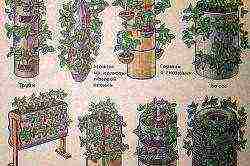
Types of containers for vertical cultivation
In Russia, the strawberry boom has just begun. More and more people, even those far from gardening, are interested in how to get excellent strawberry yields at home. This helps not only to grow a useful berry for yourself, but also to make great money. If fresh strawberries are sold out of season, then their price increases significantly. In order to understand all the intricacies of obtaining yields of this useful berry, you should know that there are basic methods of growing strawberries:
- in the open field;
- in greenhouses (protected ground);
- in plastic bags;
- using hydroponics.
Back to the table of contents
Growing strawberries outdoors 
Three-line and five-line strawberry planting schemes
This is a well-known and familiar way of growing strawberries in a garden. To get a good harvest, you need to adhere to a few simple rules:
- You need to arrange the rows of strawberries from north to south. In this case, each plant will receive maximum heat and light, which is so necessary for it for development. All this will undoubtedly affect the yield.
- The best option for growing strawberries in the open field is planting in closed-type bulk beds. They are an ordinary wooden frame that prevents the spread of plants throughout the garden.
- It should be noted that an excess of moisture for strawberries is more destructive than its lack. Therefore, the widely practiced growing of berries in holes in roofing felt does more harm than good, since moisture in this case stagnates in the soil.
- Strawberries need to be provided with timely care: watering, weeding, pest control.
Back to the table of contents
Growing strawberries in greenhouses
This method of year-round harvesting of strawberries in Russia is known as Dutch. Its essence is that seedlings are planted regularly, regardless of the season, every 1-2 months. The technology is based on the harvesting and planting of the so-called "frigo" seedlings. Despite the fact that the Dutch for greater importance shroud this process in mystery, in fact, it is incredibly simple. Frigo are well-developed strawberry rosettes selected from the total mass, which, being dug out in the fall, are stored chilled until spring in special rooms where the temperature is maintained from -1-2 degrees. But more often they prefer cooling to -1.8 degrees. That's the whole secret.As well, greenhouse strawberries can be stored in a cool basement or on the bottom shelf of a refrigerator.
As for which greenhouse produces the best strawberries (glass, polyethylene or polycarbonate), gardeners did not come to a consensus. However, much more often you can hear and read statements that polycarbonate greenhouses retain heat better and the berries are much more comfortable there. The soil in which it develops and bears fruit is important for this capricious berry. It is desirable that it be sterile and free of pathogens and weed seeds. It is best to make a mixture of steamed peat and perlite, to which mineral wool or coconut fiber is added as a substrate.
Back to the table of contents
Growing strawberries in plastic bags 
Seedling options: 1 - uterine bush with rooted rosettes that need to be separated; 2 - unrooted sockets, they are usually grown in a school; 3 - planting material with an open root system, 4 - planting material with a closed root system.
This is a fairly new method that allows you to get harvests of strawberries every season. Seedling bags can be placed in any room where it is possible to set a certain temperature and light conditions. Dense plastic bags are used as containers for soil. The main difficulty will be the choice of soil and strawberry varieties. However, the process will be greatly facilitated if you purchase land ready for growing it in a gardening store.
You can also make potting soil yourself. To do this, you need to mix steamed garden soil with a small amount of ash, sawdust and add organic fertilizer in the right proportion. Do not forget that at a fairly high temperature in the room, the soil in plastic bags will begin to rot. Therefore, the room in which the strawberries are grown must be well ventilated.
The soil bags can be positioned both vertically and horizontally. The main condition when placing them is to maintain such a distance that not a single strawberry bush is in the shade. Accordingly, you need to think carefully about the location of the lighting fixtures. The room temperature during the cold season can be maintained using various heaters.
Before planting seedlings in the ground in plastic bags, small cuts are made in a checkerboard pattern at a distance of 18-20 cm from one another. In the future, each bag is supplied with an original irrigation system. Most often, it is made in the form of droppers, the ends of which fit the roots of plants. In order for the water to flow freely in the desired direction, a 2-liter plastic bottle is suspended above each bag, with several small holes in the lid, from which 3-5 droppers are removed. For one day, a 2-liter bottle of water is enough for one bag of seedlings.
Back to the table of contents
Growing strawberries using hydroponics
There are several hydroponic methods of obtaining year-round strawberry harvests. Which one to choose depends on the number of plants and the location set aside for their growth. If there are a lot of plants, and the automatic control system of the hydroponic plant is well established, you can use the method of periodic flooding. Deep sea cultivation method for strawberries is not entirely acceptable. The fact is that strawberries are wasting away from an excess of moisture. In the next hydroponic method, the plant bushes are planted in a special substrate, and a nutrient solution continuously circulates along the bottom of the plastic container in which they are located, which washes each root of the strawberry. This method is considered optimal for growing strawberries.
Back to the table of contents
Strawberry varieties suitable for year-round cultivation
All varieties of this plant can be divided into three main groups:
- those that yield one harvest per year;
- those that are able to bear fruit year-round (remontant);
- varieties with rather small fruits.

After correct planting, the seedlings will not be pulled out of the ground if you slightly pull on the leaves.
You can grow strawberries in two ways: outdoors and indoors. In order to obtain year-round harvests, seeds of the second type should be used. If you are determined to grow strawberries on an industrial scale, you should carefully study the characteristics of each variety suitable for fruiting indoors. Year-round cultivation of strawberries is possible in any of the above ways, except for the first one (outdoors). In this case, every 2-3 months, you can send the next portion of the crop for sale.
It is advisable to choose a variety of berries that will not be too burdensome to care for. It must be resistant to strawberry diseases, have a high yield and have an attractive appearance. All of the varieties listed below have these advantages. With them, it is possible to grow strawberries in winter. These varieties have been bred over many years of selection and are currently considered the best.
Strawberry variety Elizabeth 2
This is a large garden remontant strawberry. The berries of this strawberry are superior in size to other varieties. It bears fruit not only on bushes, but also on rosettes of the same year. This variety has a peculiarity: it requires annual renewal. The taste of this strawberry is unusually high. It is sweet and medium-bodied. The advantage of the Elizaveta 2 variety is its excellent transportability.
Honey strawberry variety
This is a renovated greenhouse strawberry. The variety has a high yield and is perfect for growing for sale, since the berries retain their shape for a long time. The color of this strawberry is dark red with a glossy sheen. The berries are dense and large, sometimes reaching a weight of 45 g. Honey is resistant to temperature extremes and diseases inherent in the strawberry family. A feature of this variety is that it is advisable to pick berries only after they are fully ripe.
Marshal strawberry variety
The berries are tasty, sweet and have a rich red color. Plants of this variety are interesting in that they rapidly grow large leaves that shade the entire space and prevent weeds from growing. Therefore, this remontant strawberry is beneficial in that it does not need constant care. Marshal does not require regular watering and tolerates drought well. Therefore, this variety is a favorite in America and Japan.
Strawberry variety Albion
Many professionals consider this to be the best remanufactured greenhouse strawberry. Its fruiting period is one of the longest, up to frost. The peculiarity of this variety is its unique taste and pronounced aroma. Albion is incredibly resistant not only to the vagaries of the weather, but also to disease. It produces large, beautifully shaped fruits.
Strawberry variety Gigantella
The peculiarity of this variety is that the size of the berries depends on the regularity of watering. These plants require careful maintenance. The first berries are up to 100 g in weight, and the diameter of the fruit can reach 9 cm. This is a tasty, high-yielding greenhouse remontant strawberry. She has beautiful corrugated leaves.
Ampel strawberry
These are very special varieties of strawberries. There are several types of them, and they differ from ordinary strawberries in that they are climbing plants that are often used for decorative purposes. It falls in a beautiful wave from vertical supports and is suitable for growing in pots. Caring for her is the same as for ordinary remontant varieties: regular watering and feeding. Therefore, it is quite easy to grow it.
One of the best ampelous varieties is Alyuba.Its fruits are large, elongated, of a beautiful red color. The berries taste very sweet and have a dense core. Among the ampelous varieties, the earliest variety is Geneva. These plants are the highest yielding of all climbing strawberries. Up to 3 kg of fruit can be harvested from one bush.
A very interesting site about growing and caring for strawberries, a description of strawberry varieties, useful tips for a gardener.
